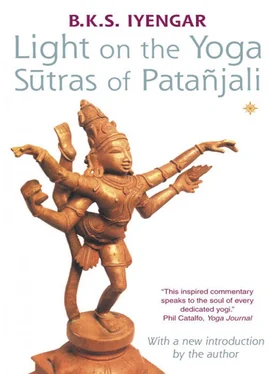The cit (seer, soul, cosmic consciousness) is a passive, omniscient witness, whereas the citta (created or ‘sprouted’ consciousness) is active, impressionable and engaged, because it is involved in a direct relationship with the outside world. But when that involvement is analysed, controlled and brought to stillness, the citta gravitates towards its source, the cit , and takes on its characteristics, so that for the realized being cit and citta become one. The problem is that for the average person, the sprouted consciousness appears to be the seer, while in reality it merely masks the seer. Studying citta , we come to understand that it has no light of its own, but is dependent on its progenitor, the seer. Until this realization dawns, consciousness acts as a prism, distorting vision. Once it merges with the seer it becomes a perfect reflector, as well as a reflection, mirroring its own pure image, the soul reflecting on the soul.
So we see that citta can be pulled in two directions: outwards towards its mother, nature, prakrti , or inwards towards its father, spirit, purusa. The role of yoga is to show us that the ultimate goal of citta is to take the second path, away from the world to the bliss of the soul. Yoga both offers the goal and supplies the means to reach it. He who finds his soul is Yogesvara, Lord or God of yoga, or Yogiraja , a King among yogis.
Now, nothing is left to be known or acquired by him.
Patañjali warns that even such exalted yogis are not beyond all danger of relapse. Even when oneness between cit and citta is achieved, inattention, carelessness, or pride in one’s achievement await opportunity to return, and fissure the consciousness. In this loss of concentration, old thoughts and habits may re-emerge to disturb the harmony of kaivalya.
If this takes place, the yogi has no alternative but to resume his purificatory struggle in the same way as less evolved people combat their own grosser afflictions.
The dawn of spiritual and sorrowless light
If the Yogesvara’s indivisible state is unwaveringly sustained, a stream of virtue pours from his heart like torrential rain: dharma megha samadhi , or rain-cloud of virtue or justice. The expression has two complementary overtones. Dharma means duty; megha means cloud. Clouds may either obscure the sun’s light or clear the sky by sending down rain to reveal it. If citta’s union with the seer is fissured it drags its master towards worldly pleasures ( bhoga). If union is maintained it leads the aspirant towards kaivalya. Through yogic discipline, consciousness is made virtuous so that its possessor can become, and be, a yogi, a jñanin , a bhaktan and a paravairagin.
All actions and reactions cease in that person who is now a Yogesvara. He is free from the clutches of nature and karma. From now on, there is no room in his citta for the production of effects; he never speaks or acts in a way that binds him to nature. When the supply of oil to a lamp is stopped, the lamp is extinguished. In this yogi, when the fuel of desires dries out, the lamp of the mind cannot burn, and begins to fade on its own. Then infinite wisdom issues forth spontaneously.
The knowledge that is acquired through senses, mind and intellect is insignificant beside that emanating from the vision of the seer. This is the real intuitive knowledge.
When the clouds disappear, the sky clears and the sun shines brilliantly. When the sun shines, does one need artificial light to see? When the light of the soul blazes, the light of consciousness is needed no longer.
Nature and its qualities cease to affect the fulfilled yogi. From now on they serve him devotedly, without interfering with or influencing his true glory. He understands the sequence of time and its relationship with nature. He is crowned with the wisdom of living in the eternal Now. The eternal Now is Divine and he too is Divine. All his aims of life are fulfilled. He is a krtharthan , a fulfilled soul, one without equal, living in benevolent freedom and beatitude. He is alone and complete. This is kaivalya.
Patañjali begins the Yoga Sutras with atha , meaning ‘now’, and ends with iti , ‘that is all’. Besides this search for the soul, there is nothing.
Yoga Sutras

Samadhi means yoga and yoga means samadhi. This pada therefore explains the significance of yoga as well as of samadhi: both mean profound meditation and supreme devotion.
For aspirants endowed with perfect physical health, mental poise, discriminative intelligence and a spiritual bent, Patañjali provides guidance in the disciplines of practice and detachment to help them attain the spiritual zenith, the vision of the soul (atma-darsana).
The word citta has often been translated as ‘mind’. In the West, it is considered that mind not only has the power of conation or volition, cognition and motion, but also that of discrimination.
But citta really means ‘consciousness’. Indian philosophers analysed citta and divided it into three facets: mind ( manas ), intelligence ( buddhi ) and ego, or the sense of self (ahamkara). They divided the mental body into two parts: the mental sheath and the intellectual sheath. People have thus come to think of consciousness and mind as the same. In this work, consciousness refers both to the mental sheath (manomaya kosa) as mind, and to the intellectual sheath (vijñanamaya kosa) as wisdom. Mind acquires knowledge objectively, whereas intelligence learns through subjective experience, which becomes wisdom. As cosmic intelligence is the first principle of nature, so consciousness is the first principle of man.
 I.1 atha yoganusAsanam
I.1 atha yoganusAsanam
| atha |
now, auspiciousness, a prayer, a blessing, benediction, authority, a good omen |
| yoga |
joining, union, junction, combination, application, use, means, result, deep meditation, concentration, contemplation of the Supreme Spirit |
| anusAsanam |
advice, direction, order, command, instructions, laying down rules and precepts, a revised text, introduction, or guide given in procedural form. Thus, it means guidance in the codes of conduct which are to be observed, and which form the base from which to cultivate one’s ethical and spiritual life. |
With prayers for divine blessings, now begins an exposition of the sacred art of yoga.
Now follows a detailed exposition of the discipline of yoga, given step by step in the right order, and with proper direction for self-alignment.
Patañjali is the first to offer us a codification of yoga, its practice and precepts, and the immediacy of the new light he is shedding on a known and ancient subject is emphasized by his use of the word ‘now’. His reappraisal, based on his own experience, explores fresh ground, and bequeathes us a lasting, monumental work. In the cultural context of his time his words must have been crystal clear, and even to the spiritually impoverished modern mind they are never confused, although they are often almost impenetrably condensed.
Читать дальше


 I.1 atha yoganusAsanam
I.1 atha yoganusAsanam










